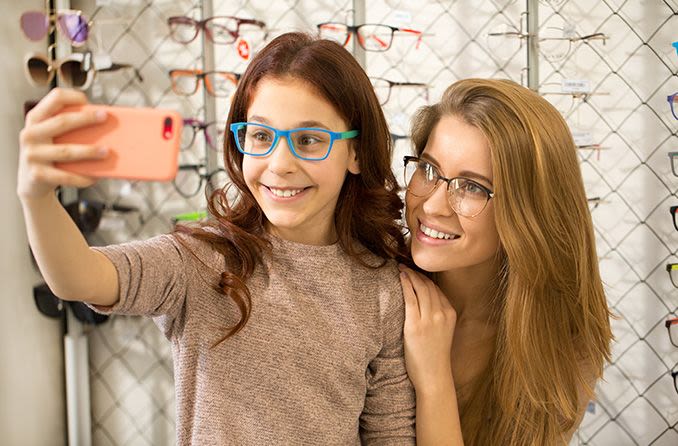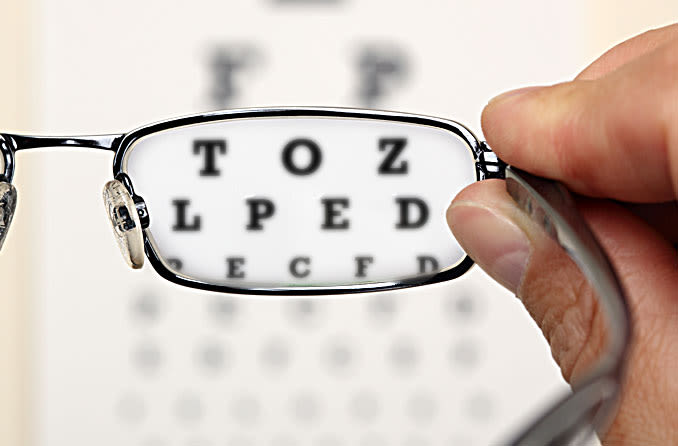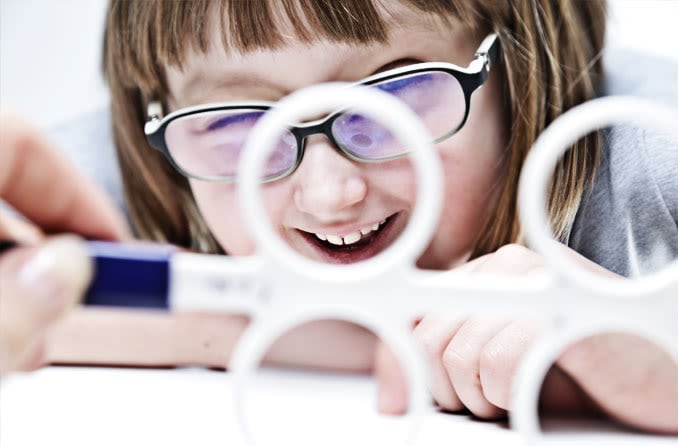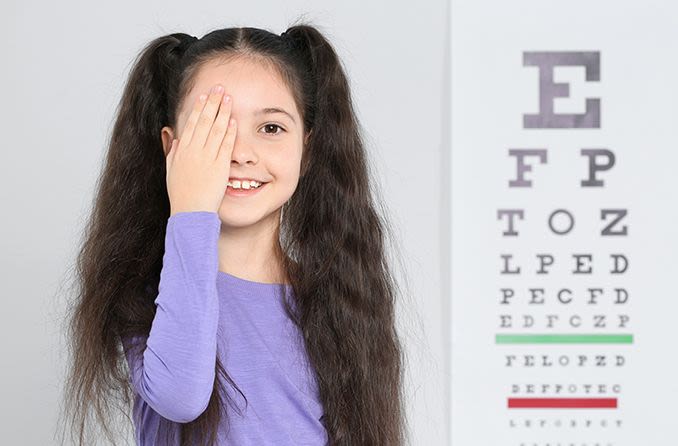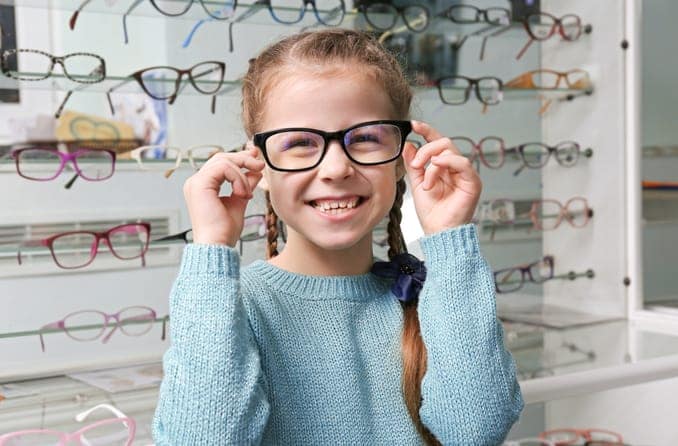My child says their new glasses make their vision blurry. What should I do?
Your child has a new pair of glasses and they’re telling you that their vision is blurry. A new prescription or frame can be disorienting. It can take 2-3 days, or even a couple of weeks, to adjust to new glasses. Talk to them about the glasses and their vision to learn more about their symptoms.
Find out if there is something else about the glasses that may be making them feel uncomfortable. Here are a few causes of discomfort and blurry vision with new glasses, and what you can do to help. If they say they cannot see clearly even after the adjustment period, contact their eye doctor.
The first pair of glasses may make them feel awkward
Wearing glasses for the first time can be both exciting and anxiety-producing for a child.
They may be seeing clearly now — but feeling awkward about wearing something on their face. It may take them a while to adjust to their new “look” and feel comfortable with their new self-image as someone who wears glasses.
In addition, it will take them some time to adapt to the sensation of the frames on their face. It will also take a few days to adjust to the outline of the frame in their peripheral vision.
Your child has a lot of new physical and emotional sensations to process, and it is normal to want to return to the comfort of their “old” self. Reassure your child that you love them and their new look. If one of their friends has glasses, remind them that how they feel about their friend didn’t change once they started wearing glasses.
Adjusting to a new prescription
Your child was used to the way life looked through their old glasses, or without glasses. While the world may be in clearer focus with their new glasses, it looks different. Some young children may have adjusted to blur. If they had uncorrected astigmatism, seeing things without distortion may feel unnatural, or “blurry.”
If your child wears glasses for myopia (nearsightedness), they probably struggled with seeing the front of the classroom or recognizing their friends across the playground at recess.
If they were prescribed glasses for hyperopia (farsightedness), they likely struggled with reading and seeing their tablet or computer clearly.
Ask your child what looks blurry with their new glasses. Is their vision blurry when they look far away or when they look close up? They may have gotten used to holding their reading material or tablet very close and need to hold it a bit farther now. Are they able to see the leaves on the trees and road signs that they weren’t able to read before? If the answer is yes, they may be experiencing discomfort from their glasses other than visual blur.
Adjusting to a new frame
If the new glasses are rubbing your child’s skin and causing discomfort, they may complain about it, even describing their glasses as blurry.
You may be aware that the eyes and brain need time to adapt to the new glasses. But the face and skin are adjusting to a new sensation as well. When a new frame sits on the nose, the slight pressure can cause discomfort and annoyance at first. Even if your child’s prescription stayed the same, a new frame can take some time to get used to.
When you and your child pick up their new glasses, take your time with the optician. It is important that the glasses fit comfortably and rest in the correct position.
If your child’s glasses look like they are not fitting them well, take them back to the optician at your eye doctor’s office. They can take a look to see if your child’s glasses were bent out of position. If your child has high astigmatism and the glasses are sitting on their face in a tilted position, they may be causing some blurry vision.
Adjusting the glasses so that they are positioned correctly and fit comfortably may correct the issue.

Headaches and eye strain with the new glasses
Adjusting to new glasses may initially cause some mild headaches. Sometimes the experience of getting new glasses can be stressful for a child. A stress headache may be accompanied by a sensation of blurry vision. Eye strain may occur if your child is trying to squint through her glasses or opening her eyes wide to adapt to her new vision.
You can help to relieve your child’s headache and eye strain by encouraging her to rest, rehydrate and take a break. If headaches or eye strain are severe or last for several days, it's important to contact your doctor. Make a note of what triggers the headache or eye strain and how long it lasts. Let your doctor know what relieves the discomfort as well.

SEE RELATED: An overlooked reason your child may be getting headaches
Blurry vision when reading or looking at a screen
If your child is complaining of blur when they read a book or look at a screen, speak to the eye doctor about evaluating them for binocular vision (using both eyes together to keep an image clear) or accommodative issues (focusing to see up close).
Convergence Insufficiency (CI)
Eye muscles called extraocular muscles control eye movement. These eye muscles keep the eyes turned slightly inward, or converged, when looking at a near object.
Convergence is necessary to maintain a clear image when focusing at something up close. Convergence insufficiency is a reduced ability to converge the eyes when looking at near objects.
Accommodative Insufficiency (AI)
The accommodation system of the eye adapts to changes in viewing distance so that incoming light rays are properly focused on the retina. Accommodation is when the lens of the eye adjusts so that a near object can be seen clearly.
When the ability to accommodate is reduced it is called accommodative insufficiency.
Both convergence insufficiency (CI) and accommodative insufficiency (AI) will cause blurry vision at near distances. Sometimes, when a child’s distance vision is corrected with glasses, additional vision issues such as CI and AI then become apparent.
There are optical and therapeutic strategies that can help with these conditions, such as reading glasses and vision therapy.
Looking up close through a new prescription can sometimes fatigue the eyes, causing some blur. Strategies to decrease eye strain include the 20-20-20 rule and the elbow rule.
Advise your child to follow the 20-20-20 rule by looking at least 20 feet away, every 20 minutes, for 20 seconds when working at a computer for several hours.
The elbow rule ensures that a screen (or book) is farther than the distance between your hand and elbow. To apply this rule, have your child make a fist next to their face and extend their elbow toward the screen or book. The distance between them and the book or screen should be farther than their elbow.
Keeping glasses clean
Kids are not often gentle on their glasses. It’s not uncommon for them to grab their glasses by the lens when taking them on and off. It doesn’t take much oil and dirt on the lens to cause blurry vision. Provide your child with a lens cleaning cloth for school and at home.
Demonstrate how to pick up and put away glasses without touching the lens. Show your child how to fold the glasses when they put them down. Folding their glasses will help them to keep their glasses clean. It will also help to keep the glasses from getting bent out of shape.
If blurry vision continues with the new glasses
If these strategies do not help your child adjust to their new glasses, contact the eye doctor and explain your concerns. Explain to the eye doctor whether their vision is blurry at a distance or near. Also, let them know if anything makes their vision less blurry.
Additionally, share any additional symptoms they may be experiencing. Your eye doctor’s office can evaluate the cause of your child’s blurry vision with their new glasses.

